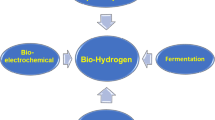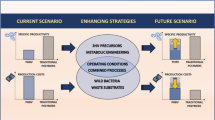Abstract
Two-step fermentation was utilized to increase PHB production. Cupriavidus necator was firstly cultivated in molasses medium for 144 h. Afterward, cells were recovered and extracted for PHB. The highest biomass (2.10 g/L) and PHB (62.38% of DCW) were obtained in the first reactor after 108 h of incubation. Filtrate after cell recovery were overflowed to the second reactor. Filtrate after cell recovery contained sugar and organic acids. Therefore, it was suitable to be re-utilized as substrate for PHB. In the second reactor, 10% of C. necator was inoculated and incubated for 120 h. The highest biomass (1.67 g/L) and PHB (67.66% of DCW) were achieved after 96 h of incubation. PHB was further utilized as substrate for biolubricant. The production of biolubricant involved a two-stage transesterification. The biolubricant from PHB passed the ISO VG-15 commercial standards for hydraulic systems and many other industrial applications.




Similar content being viewed by others
References
International Energy Agency (IEA) (2007) World energy outlook 2007. http://www.iea.org/textbase/npdf/free/2007.pdf
Shahid EM, Jamal Y (2011) Renew Sustain Energy Rev 15:4732
Sahoo PK, Das LM, Babu MKG, Naik SN (2007) Fuel 86:448
Basha SA, Raja Gopal K, Jebaraj S (2009) Renew Sustain Energy Rev 13:1628
Demirbas A (2009) Energy Conserv Manag 50:2239
Refaat AA (2010) Int J Environ Sci Technol 7:183
Yang CY, Fang Z, Li B, Long YF (2012) Renew Sustain Energy Rev 16:2178
Bilal S, Mohammed-Dabo I, Nuhu M, Kasim SA, Almustapha IH, Yamusa YA (2013) J Chem Eng Mater Sci 4:72
Renewable Energy Policy Network for the 21th Century (REN21) (2012) Renewables 2011: Global Status Report, Paris
Askew MF (2004) IENICA: biolubricants market data sheet. Central Science Laboratory
Sangkharak K, Pichid N, Yunu T, Srinak K, Sornnum S, Prasertsan P (2016) Chiang Mai J Sci 43:808
Miao X, Wu Q (2006) Bioresour Technol 97:841
Sindhu R, Silviya N, Binod P, Pandey A (2013) Biochem Eng J 78:67
Wellen RMR, Rabello MS, Fechine GJM, Canedo EL (2013) Polym Test 32:215
Zhang X, Luo R, Wang Z, Deng Y, Chen GQ (2009) Biomacromolecules 10:707
Wang SY, Wang Z, Liu MM, Xu Y, Zhang XJ, Chen GQ (2010) Biomass Bioenerg 34:1216
Chaijamrus S, Udpuay N (2008) Agric Eng Int 10:1
Shimizu H, Shioya S, Suga KI (1990) Eur J Appl Microbiol 7:1
Sangkharak K, Prasertsan P (2012) J Gen Appl Microbiol 58:173
Li SY, Dong CL, Wang SY, Ye HM, Chen GQ (2011) Appl Microbiol Biot 90:659
APHA (1995) Standard method for the examination of water and wastewater federation, 19th edn. APHA, Washington D.C.
Coats ER, VandeVoort KE, Darby JL, Loge F (2011) J Environ Eng 137:46
Lee S, Yu J (1997) Resour Conserv Recycl 19:151
Zhang LX (1986) Experimental methods and techniques in biochemistry. People’s Education Press, Beijing
Srimachaia T, Nuithitikula K, O-thong S, Kongjan P, Panpong K (2015) Energy Procedia 79:111
Chen GQ (2009) Chem Soc Rev 38:2434
da Silva JAC, Soares VF, Fernandez-Lafuente R, Habert AC, Freire DMG (2015) J Mol Catal B 122:323
White J (1954) Yeast technology. Chapman & Hall, Ltd., London
Gomaa EZ (2014) Braz Arch Biol Technol 57(1):145
Tabatabaei M, Abdul Rahim R, Abdullah N, Wright ADG, Shirai Y, Sakai K, Sulaiman A, Ali Hassan M (2010) Process Biochem 45:1214
Chanprateep S, Katakura Y, Visetkoop S, Shimizu H, Kulpreecha S, Shioya S (2008) J Ind Microbiol Biotechnol 35:1205
Khatipov E, Miyake M, Miyake J, Asada Y (1998) FEMS Microbiol. Lett 162:39
Avnimelech Y (2009) Biofloc technology—a practical guide book. The World Aquaculture Society, Louisiana
Verlinden RA, Hill DJ, Kenward MA, Williams CD, Radecka I (2007) J Appl Microbiol 102(6):1437
Dawes EA (1988) Biosci Rep 8:537
Supono U, Hutabarat J, Prayitno SB, Darmanto YS (2013) Coast Dev 16:114
Wei YH, Chen WC, Huang CK, Wu HS, Sun YM, Lo CW, Janarthanan OM (2011) Int J Mol Sci 12:252
Ferrari RA, Oliveira VS, Scabio A (2005) Sci Agric 62:291
Acknowledgements
The authors would like to thank Thailand Research Fund (TRF) Grant (Project Number RTA6080010) and the Research and Development Institute at Thaksin University for financial support. Finally, we would like to thank Mr. Christopher Joseph Forti (English adviser and English proof-reader, Thaksin University) for useful comments and suggestions on the language and structure of our manuscript.
Author information
Authors and Affiliations
Corresponding author
Rights and permissions
About this article
Cite this article
Keunun, P., Rakkarn, T., Yunu, T. et al. The Production of Polyhydroxybutyrate by Two-Step Fermentation and the Application of Polyhydroxybutyrate as a Novel Substrate for a Biolubricant. J Polym Environ 26, 2459–2466 (2018). https://doi.org/10.1007/s10924-017-1140-0
Published:
Issue Date:
DOI: https://doi.org/10.1007/s10924-017-1140-0




